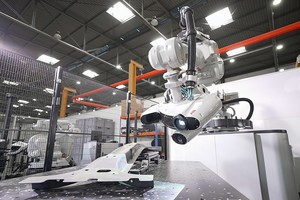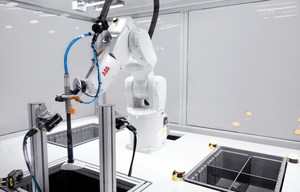
 |
Charlotte Stonestreet
Managing Editor |
| Home> | AUTOMATION | >Robots | >AI boosts the power of robotic solutions |
AI boosts the power of robotic solutions
10 October 2023
Robotic solutions answer more of industry’s key challenges by harnessing the power of Artificial Intelligence. Julian Ware explains

THE COMBINED impact of the COVID ‘hangover’, war in Europe, energy price hikes and associated inflation have made life tough for UK households and businesses alike. Yet for manufacturers, the added pressure to address challenges such as labour shortages and supply chain disruptions is increasingly nudging them towards robotic automation as a way to build resilience and future proof their businesses. The upside is that this could pave the way for a much-needed boost in industrial productivity.
Earlier this year, the International Federation of Robotics (IFR) predicted the key trends that would shape the market for industrial robots in the coming months.
Top of the list is improving energy efficiency, with robots helping in diverse ways such as reducing the need to heat production lines or adopting their own, smart, power-saving modes of operation. Next is the ability of robots to support reshoring, helping companies to overcome tight labour markets and build more resilient supply chains. Robots are also becoming easier to use for non-experts, with preconfigured solutions and straightforward user interfaces increasingly the norm. The growing availability of refurbished robots is also bolstering their popularity among companies looking for more sustainable manufacturing solutions.
While all the factors mentioned are important, it is advances in artificial intelligence (AI) that arguably have the biggest potential to generate a long-term shift towards more-widespread robotic automation.
Why AI?
AI unlocks a wide range of benefits in manufacturing. AI and machine learning play a growing role wherever robotic systems can benefit from optimised processes, predictive maintenance or vision-based manoeuvring, for instance. The greater the variability and unpredictability of the production environment, the more likely it is that AI algorithms can provide a more cost-effective and efficient solution than was previously practical. This is true in fixed production cells, as well as in environments where mobile robots need to respond appropriately to the various objects or people they encounter.
Most industrial applications so far have relied on analytical AI, which can trawl through vast reservoirs of data to spot important patterns. This is great for applications such as predictive maintenance. Looking further ahead, generative AI will unlock even more benefits, such as the ability to program robots to carry out a new task by simply talking to them.
According to the IFR, AI (together with the other key drivers) is expanding the uptake of robots beyond traditional, large-scale manufacturing into logistics and warehouses, laboratories, workshops and small production environments. Many small and medium size enterprises (SMEs) are embracing automation for the first time, while organisations in vertical segments such as healthcare, fast moving consumer goods, retail, construction and logistics are also exploring the possibilities presented by robotic automation.
Perhaps the easiest way to illustrate how AI is already increasing the ability of robots to deliver more effective production solutions is to look at some specific examples.
Pick and place
First up is ABB’s AI-enabled Robotic Item Picker. The Item Picker uses a combination of machine vision and AI to determine the optimal grasp points for each item before the suction gripper picks it up and places it into the designated bin. The system does not require any human supervision or information about the physical attributes of the items it picks. With a picking rate of up to 1,400 items per hour, it enables businesses to handle more orders without increasing headcount or time.
Featuring a robot, suction grippers and proprietary machine vision software, this system fully automates complex picking and placing tasks for a range of items including cuboids, cylinders, pouches, boxes, polybags, and blister packs. Until recently, only the dexterity and flexibility of humans could have dealt reliably with such a wide range of items.
Fast, accurate inspection
Meanwhile, the 3D Quality Inspection system from ABB simplifies the way manufactured products are measured and checked. Based on structured light and photogrammetry, 3D Quality Inspection is capable of measuring faults that are less than half the width of a human hair at a pace that is dramatically faster than traditional measuring inspection tools. 3DQI not only offers quick and accurate quality checks, but also reduces expensive rework and scrappage.
Unlike traditional measuring machines that use a contact-based method to inspect manufactured products, 3DVM uses a 3D sensor to capture multiple images of the product and compare it to a master CAD model. This contact-less technique allows operators to test for quality at a much faster rate and with more information than traditional tools and manual inspections.
The system targets the market for off-line measuring and quality inspection, while its modularity allows customisation or expansion to meet evolving business needs. All the programming of the robot can be done offline using ABB’s RobotStudio and sent to the single logic controller that controls the entire robot inspection setup. This minimises the time and effort needed to commission the system on site.
3D vision on the move
Earlier this year, ABB Robotics transformed its Autonomous Mobile Robots (AMRs) with the addition of Visual Simultaneous Localisation and Mapping (Visual SLAM) technology, enabling AMRs to make intelligent navigation decisions based on their surroundings. Using AI-enabled 3D vision to perform location and mapping functions, ABB’s Visual SLAM AMRs make production faster, more flexible, efficient and resilient while taking on dull, dirty and dangerous tasks so people can focus on more rewarding work.
Visual SLAM combines AI and 3D vision technologies to guarantee a superior performance in comparison to other guidance techniques for AMRs. Other forms of navigation such as magnetic tape, QR codes and traditional 2D SLAM all require additional infrastructure to function. This makes Visual SLAM AMRs much more flexible and able to handle an expanding range of production and distribution tasks.
Visual SLAM uses cameras mounted on the AMR to create a real time 3D map of all the objects in the surrounding area. The system can differentiate between fixed navigation references such as floors, ceilings and walls that need to be added to the map, and objects such as people or vehicles that move or change position. The cameras detect and track natural features in the environment enabling the AMR to dynamically adapt to its surroundings and determine the safest and most efficient route to its destination. Visual SLAM offers accurate positioning to within three millimetres.
By eliminating the need to change the environment, stop production or add infrastructure before introducing a new robot, Visual SLAM technology helps to reduce commissioning time by up to 20% compared to 2D SLAM. This significantly reduces the time needed to integrate a new AMR into an existing fleet. The technology can be used at scale with fleets updated remotely.
The technology analyses raw data only, with no visual images saved on either the AMR or on a server. This ensures that any information about the AMR’s working environment remains secure.
Accelerated development
The statistics on robotic deployments clearly demonstrate that the increasing versatility of AI-enabled systems is encouraging more companies to adopt robotic solutions.
The latest available IFR figures for robotic deployments date back to 2021, when the global robot population reached almost 3.5 million. Since then, AI has been progressively equipping industrial robots with the kind of game-changing new capabilities that generate rapid market expansion. For example, Germany installed around 26,000 units in 2022 alone, while Italy installed a further 12,000 and France 7400.
As competitors around Europe and beyond recognise the need to boost their resilience and productivity with robotic solutions, companies in the UK increasingly recognise that they cannot afford to fall behind.
Julian Ware is UK and Ireland sales manager at ABB Robotics
- YuMi scoops top awards
- Why it's time to go back to school to build a more competitive UK manufacturing sector
- Compact robots
- Vision-powered autonomy
- Cobots alleviate workforce shortages
- AI-powered robots rebuild homes in LA area
- Taking automation to where it’s needed
- AI-enabled robotic item picker
- Robots help bring quality hand-crafted ceramics production back to Stoke
- ABB’s Robot Podcast returns
- Balls to Gravity
- ROBOTS GIVE FASTER CELL TOOL CHANGE TIMES
- ROBOT FOR DELICATE ASSEMBLY
- NUMBER OF ROBOTS IN UK ON THE RISE
- The future is bright - The future is automation!
- High Demand For Grant
- More Capacity, Less Space
- FREEBIRD - THE THIRD DIMENSION
- PRECISION ROBOT CELL FOR THE PHARMACEUTICAL INDUSTRY
- ROBOT SALES REACH ALL TIME HIGH





















